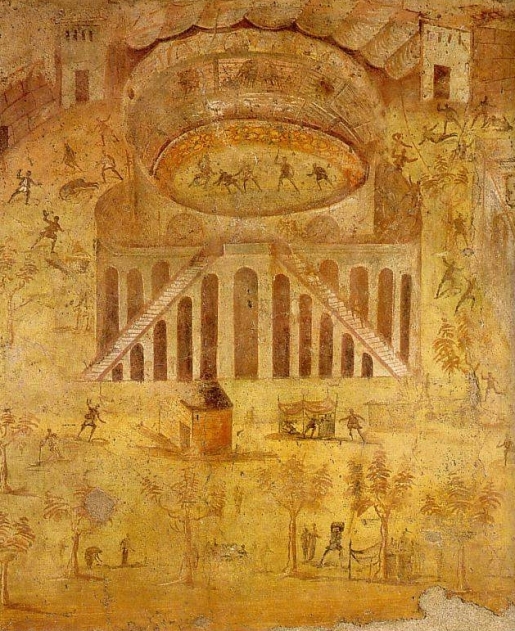The fresco above, today on display in the National Archaeological Museum in Naples, shows the Amphitheater of Naples with scenes of street violence and mayhem.1 In this case we are quite lucky because this exact incident, a riot in 59 A.D. between the Pompeians and the residents of Nuceria, is described by the historian Tacitus:
Sub idem tempus levi initio atrox caedes orta inter colonos Nucerinos Pompeianosque gladiatorio spectaculo, quod Livineius Regulus, quem motum senatu rettuli, edebat. Quippe oppidana lascivia in vicem incessentes probra, dein saxa, postremo ferrum sumpsere, validiore Pompeianorum plebe, apud quos spectaculum edebatur. Ergo deportati sunt in urbem multi e Nucerinis trunco per vulnera corpore ac plerique liberorum aut parentum mortes deflebant. Cuius rei iudicium princeps senatui, senatus consulibus permisit. Et rursus re ad patres relata, prohibiti publice in decem annos eius modi coetu Pompeiani collegiaque, quae contra leges instituerant, dissoluta; Livineius et qui alii seditionem conciverant exilio multati sunt.2
The painting captures well the chaos of the scene as described by Tacitus. We can see the variety of brawling going on. Some of the stick figures are holding weapons, others appear unarmed, some are clearly throwing stones, and one figure down in the bottom right seems to be heaving a large stone or marble block. And in the middle of it all stands the Pompeian Amphitheater, the source of all the trouble, with its signature double flight of stairs and tall arches.
This fresco comes from a small house in Pompeii, known by it’s archaeological address 1.3.23. Perhaps one of the biggest questions raised by the painting is why anyone would choose to paint this scene on his wall in the first place. It has been thought, on the basis of an identification made by the late 19th and early 20th century archaeologist Matteo della Corte, that this house belonged to a certain Actius Anicetus Castre(n)sis, a pantomimist and possibly ex-gladiator. The evidence, however, for this identification is rather slim.3 The name Actius Anicetus Castre(n)sis comes from graffiti found around the city written by fans of members of a theater troupe, including three pieces of such graffiti from house 1.3.23 itself. This example is typical of the sort of graffiti,
Some of the graffiti that mentions Actius also includes the name “Castresis,” leading to della Corte’s conclusion that they are the same man. Three inscriptions possibly mentioning Actius are found on the facade of 1.3.23, providing the basis for della Corte’s identification. The further identification of Actius as an ex-gladiator comes from a combination of the name “Castre(n)sis” (lit. “the Campaigner”) with the presence of this magnificent fresco of the amphitheater riot in the house.
It doesn’t take Franklin very much ink to rip apart della Corte’s reading of the graffiti outside 1.3.23 and his identification of Actius with Castresis.5 He leaves untouched, however, della Corte’s assumption that the amphitheater fresco shows that the resident of 1.3.23 was an ex-gladiator. Is that really the only reasonable explanation for the presence of this mosaic in a private home? If the owner of 1.3.23 were an ex-gladiator, it is curious that of all the possible scenes involving the amphitheater that he could have chosen to have painted, he chose a scene, the riot of 59 A.D., which doesn’t actually include gladiatorial combat. Certainly the riot wouldn’t be the most prestigious moment in a Pompeian gladiator’s career. Furthermore it has been suggested by scholars that the event at which the riot broke out was not actually a professional gladiatorial show, but rather something like a mock fight between youth organizations that provided military training for young upper class men.6 Although it is always difficult to maintain an argument from absence in archaeology, nevertheless the identification of the house as the home of an ex-gladiator would be easier to defend if the house also included paintings individual gladiatorial scenes (consider, for example, the gladiator mosaics on display in the Galleria Borghese in Rome). As it is, any extrapolation of the owner’s occupation from the amphitheater mosaic is little more than mere speculation.
I would like to propose instead a more general motive for someone to paint a fresco depicting the riot of 59 A.D., namely the event’s importance in the local history of Pompeii. As Tacitus tells us, this seems to have been a rather serious riot. The number of casualties, both dead and wounded, was significant as we can tell from Tacitus’s emphasis on “multi” and “plerique.” For judgment the matter was referred directly to Rome itself where, after the consuls had declined the case, it was heard by the Senate itself. In punishment, the Senate banned events of the type that led to the riot (whether that means all gladiatorial shows or something more limited is a matter of scholarly debate) for no less than ten years, dissolved certain Pompeian organizations, and exiled Livineius Regulus and other powerful local politicians. For a town the size of Pompeii, such a major direct intervention in local affairs by the imperial government in Rome would have, to put it succinctly, been considered a big deal.
It was quite common for Romans to decorate their houses with frescoes depicting dramatic events from mythology, epic, or history. In terms of local history, the riot of 59 classifies as a dramatic event, a little piece of local epic, and certainly worthy of a wall decoration.
- Image source is here.
- Annales 14.17. Full Latin text is here. An English translation is available here
- For a summary of della Corte’s argument, see Franklin, James T., “Pantomimists at Pompeii: Actius Anicetus and his Troupe,” American Journal of Philology, vol. 108, no. 1 (Spring 1987), pp.97-98, available here on JStor.
- “Farewell, Actius, master of the stage.” CIL IV. 5399, reprinted in Franklin, pg. 97.
- pp. 98-99.
- see Moeller, Walter O., “The Riot of A.D. 59 at Pompeii,” Historia: Zeitschrift für alte Geschichte, Bd. 19. H. 1 (Jan. 1970), pp. 84-95. Available here.

